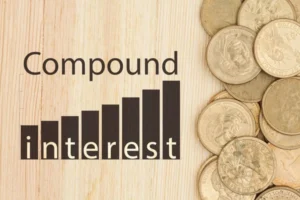
The Mathematics of Compound Interest: A Detailed Explanation
Contents
Compound Interest Formula
The Mathematics of Compound Interest: A Detailed Explanation


Introduction
Compound interest is one of the most powerful concepts in finance and a cornerstone of wealth accumulation. Unlike simple interest, which grows linearly, compound interest grows exponentially, making it possible for investments to multiply over time. Whether you’re saving for retirement, investing in the stock market, or just looking to understand the mechanics behind financial growth, mastering the mathematics of compound interest can be incredibly rewarding.
In this article, we’ll delve into the formula behind compound interest, explore examples, and weigh its advantages and disadvantages. We’ll also see how compound interest impacts different investment strategies, providing clarity on how it can help achieve long-term financial goals.
What is Compound Interest?
Compound interest is interest calculated on the initial principal as well as on the accumulated interest from previous periods. In simple terms, compound interest means that you earn interest on your interest. The compounding process leads to exponential growth, especially when left to accumulate over a long period.
The Compound Interest Formula
The basic compound interest formula is:
A=P(1+rn)ntA = P (1 + \frac{r}{n})^{nt}A=P(1+nr)nt
where:
- A = the future value of the investment/loan, including interest
- P = the principal investment amount (the initial deposit or loan amount)
- r = the annual interest rate (decimal)
- n = the number of times interest is compounded per year
- t = the number of years the money is invested or borrowed for
Breaking Down the Formula
- Principal (P): The initial sum of money that you start with.
- Interest Rate (r): The percentage at which your money grows.
- Compounding Frequency (n): This refers to the number of times interest is added to the principal each year. Common compounding frequencies include annually, semi-annually, quarterly, monthly, and daily.
- Time (t): The duration for which your money grows in the account.


Examples of Compound Interest Calculations
Let’s illustrate compound interest with examples.
Example 1: Annual Compounding
Suppose you invest $1,000 at an annual interest rate of 5%, compounded annually, for 10 years.
Using the formula:
A=1000(1+0.051)1×10A = 1000 (1 + \frac{0.05}{1})^{1 \times 10}A=1000(1+10.05)1×10 A=1000×(1.05)10A = 1000 \times (1.05)^{10}A=1000×(1.05)10 A=1000×1.6289A = 1000 \times 1.6289A=1000×1.6289 A=1628.89A = 1628.89A=1628.89
After 10 years, the investment grows to $1,628.89. The interest earned is $628.89, which is significantly higher than what you would have earned with simple interest.
Example 2: Quarterly Compounding
Let’s say you invest the same $1,000 at a 5% annual interest rate, but this time, interest is compounded quarterly for 10 years.
Using the formula:
A=1000(1+0.054)4×10A = 1000 (1 + \frac{0.05}{4})^{4 \times 10}A=1000(1+40.05)4×10 A=1000×(1.0125)40A = 1000 \times (1.0125)^{40}A=1000×(1.0125)40 A=1000×1.6436A = 1000 \times 1.6436A=1000×1.6436 A=1643.61A = 1643.61A=1643.61
With quarterly compounding, your investment grows to $1,643.61, earning $643.61 in interest, demonstrating that a higher compounding frequency leads to faster growth.
The Power of Compounding Over Time
Compound interest is particularly beneficial when investments are allowed to grow over a long period. The concept of “time in the market” is critical, as the longer the investment period, the more pronounced the compounding effect becomes.
For instance, investing $1,000 at 5% interest compounded annually for 30 years grows to approximately $4,321.94. That’s a growth of over 300%, driven solely by compound interest.
Advantages of Compound Interest
- Accelerates Wealth Growth
Compound interest provides exponential growth, allowing investments to increase significantly over time. This acceleration helps you reach financial goals faster than with simple interest.
- Encourages Long-Term Investment
Since compounding works best over a long period, it incentivizes long-term investing. This is beneficial for goals like retirement, where time is on your side.
- Encourages Consistency
Investing regularly, even small amounts, can lead to substantial growth through compounding. For instance, consistently investing a fixed amount monthly leverages the power of compound interest for continuous growth.
- Works in Various Financial Products
Compound interest applies to a range of financial products, including savings accounts, fixed deposits, bonds, and mutual funds. Understanding compounding helps you maximize growth across multiple asset types.
Disadvantages of Compound Interest
- Can Be Detrimental in Debt
While compound interest is excellent for investments, it can be disadvantageous in debt situations. For instance, credit cards often charge compound interest on balances, quickly leading to significant debt if not managed properly.
- Relies on Consistent Rates
Compound interest calculations assume a fixed rate of return. However, investment returns fluctuate, so predicting growth accurately can be challenging in real-life scenarios.
- Requires Patience
Compound interest is highly effective over the long term, but it requires patience. Short-term investors may not benefit as much, as compounding needs time to reach its full potential.
- Potential Tax Implications
In some cases, interest earned is taxable, which reduces the growth potential of the compounded returns. Without tax-sheltered accounts, part of your compounding advantage may be lost to taxes.


Compound Interest vs. Simple Interest: A Comparison
In contrast to compound interest, simple interest is calculated only on the initial principal amount, leading to linear growth. Let’s look at an example.
Example: Simple Interest Calculation
If you invest $1,000 at a 5% interest rate for 10 years with simple interest, your return is calculated as follows:
SI=P×r×tSI = P \times r \times tSI=P×r×t SI=1000×0.05×10SI = 1000 \times 0.05 \times 10SI=1000×0.05×10 SI=500SI = 500SI=500
After 10 years, you’ll have earned $500 in interest, resulting in a total of $1,500. Compound interest in this scenario would have earned you $1,628.89 instead, making it a far more attractive choice for long-term growth.
How Compounding Frequency Affects Growth
The more frequently interest is compounded, the higher the final amount. For example, monthly compounding yields more than annual compounding due to more frequent application of interest. Here’s how different compounding frequencies affect a $1,000 investment at a 5% rate over 10 years:
- Annually: $1,628.89
- Quarterly: $1,643.61
- Monthly: $1,647.01
- Daily: $1,648.66
Real-Life Applications of Compound Interest
- Retirement Savings
401(k) plans and IRAs are excellent examples of how compound interest can be used to build retirement savings. Consistently contributing a portion of your income and allowing it to grow over decades can lead to a significant nest egg.
- Education Savings
Compound interest is also powerful in 529 education savings plans. By starting early, parents can accumulate substantial funds to cover their children’s education costs, reducing the need for student loans.
- Real Estate Investments
Compound interest is prevalent in real estate, where property values increase over time. Rental income reinvested back into the property or used to acquire more assets further accelerates growth.
- Stock Market Investments
Compounding is highly effective in stocks and mutual funds. Reinvesting dividends and allowing capital gains to accumulate enables investors to leverage compounding to its fullest.


Compound Interest and Financial Planning
Building Wealth through Consistent Contributions
Making consistent contributions over time is one of the best ways to maximize compound interest. A strategy like dollar-cost averaging—investing a fixed amount at regular intervals—helps smooth out market volatility, leading to steady wealth growth.
Compound Interest Calculators
Using online compound interest calculators can help you project potential returns and make informed financial decisions. These calculators are handy for understanding how much to invest and for how long to reach a specific goal.
Potential Pitfalls of Compound Interest
While powerful, compound interest has pitfalls when mismanaged, particularly in debt situations.
Debt Accumulation on Credit Cards
Credit card debt, often compounded daily, can spiral out of control if only minimum payments are made. An initial $1,000 balance can quickly escalate into thousands in debt if left unchecked.
Over-Borrowing with Loans
Loans with compounding interest can become a financial burden if misused. Borrowers should carefully calculate monthly payments to ensure debt doesn’t outpace their ability to repay.
Conclusion
Compound interest is a vital concept in finance, enabling investors and savers to grow wealth exponentially over time. Whether used in retirement accounts, real estate investments, or education savings plans, compound interest is a powerful tool when applied wisely. By understanding the mathematics behind compounding, you can make informed financial decisions that align with your long-term goals.


FAQs
- What is compound interest? Compound interest is interest calculated on the initial principal and the accumulated interest from previous periods.
- How is compound interest different from simple interest? Simple interest is calculated only on the principal, while compound interest adds accumulated interest to the principal, leading to exponential growth.
- Why is the compounding frequency important? The more frequently interest is compounded, the faster the investment grows.
- Is compound interest good for long-term savings? Yes, compound interest is highly effective for long-term goals, allowing investments to grow exponentially over time.
- Can compound interest work against me? Yes, in debt scenarios like credit cards, compound interest can lead to significant debt accumulation if not managed carefully.





















1 comment